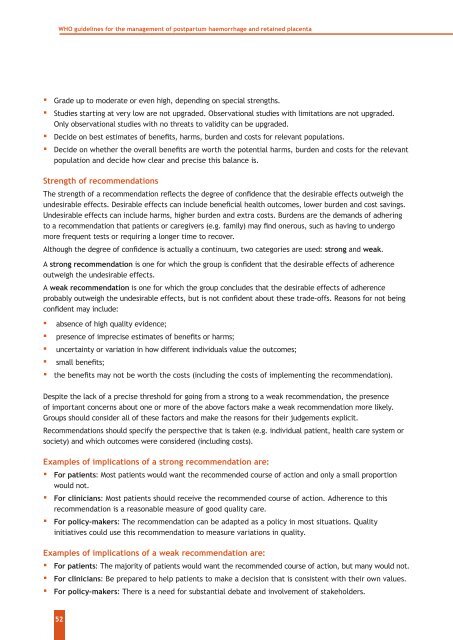WHO guidelines for the management of postpartum haemorrhage ...
WHO guidelines for the management of postpartum haemorrhage ...
WHO guidelines for the management of postpartum haemorrhage ...
You also want an ePaper? Increase the reach of your titles
YUMPU automatically turns print PDFs into web optimized ePapers that Google loves.
<strong>WHO</strong> <strong>guidelines</strong> <strong>for</strong> <strong>the</strong> <strong>management</strong> <strong>of</strong> <strong>postpartum</strong> <strong>haemorrhage</strong> and retained placenta<br />
▪ Grade up to moderate or even high, depending on special strengths.<br />
▪ Studies starting at very low are not upgraded. Observational studies with limitations are not upgraded.<br />
Only observational studies with no threats to validity can be upgraded.<br />
▪ Decide on best estimates <strong>of</strong> benefits, harms, burden and costs <strong>for</strong> relevant populations.<br />
▪ Decide on whe<strong>the</strong>r <strong>the</strong> overall benefits are worth <strong>the</strong> potential harms, burden and costs <strong>for</strong> <strong>the</strong> relevant<br />
population and decide how clear and precise this balance is.<br />
Strength <strong>of</strong> recommendations<br />
The strength <strong>of</strong> a recommendation reflects <strong>the</strong> degree <strong>of</strong> confidence that <strong>the</strong> desirable effects outweigh <strong>the</strong><br />
undesirable effects. Desirable effects can include beneficial health outcomes, lower burden and cost savings.<br />
Undesirable effects can include harms, higher burden and extra costs. Burdens are <strong>the</strong> demands <strong>of</strong> adhering<br />
to a recommendation that patients or caregivers (e.g. family) may find onerous, such as having to undergo<br />
more frequent tests or requiring a longer time to recover.<br />
Although <strong>the</strong> degree <strong>of</strong> confidence is actually a continuum, two categories are used: strong and weak.<br />
A strong recommendation is one <strong>for</strong> which <strong>the</strong> group is confident that <strong>the</strong> desirable effects <strong>of</strong> adherence<br />
outweigh <strong>the</strong> undesirable effects.<br />
A weak recommendation is one <strong>for</strong> which <strong>the</strong> group concludes that <strong>the</strong> desirable effects <strong>of</strong> adherence<br />
probably outweigh <strong>the</strong> undesirable effects, but is not confident about <strong>the</strong>se trade-<strong>of</strong>fs. Reasons <strong>for</strong> not being<br />
confident may include:<br />
▪<br />
▪<br />
▪<br />
▪<br />
absence <strong>of</strong> high quality evidence;<br />
presence <strong>of</strong> imprecise estimates <strong>of</strong> benefits or harms;<br />
uncertainty or variation in how different individuals value <strong>the</strong> outcomes;<br />
small benefits;<br />
▪ <strong>the</strong> benefits may not be worth <strong>the</strong> costs (including <strong>the</strong> costs <strong>of</strong> implementing <strong>the</strong> recommendation).<br />
Despite <strong>the</strong> lack <strong>of</strong> a precise threshold <strong>for</strong> going from a strong to a weak recommendation, <strong>the</strong> presence<br />
<strong>of</strong> important concerns about one or more <strong>of</strong> <strong>the</strong> above factors make a weak recommendation more likely.<br />
Groups should consider all <strong>of</strong> <strong>the</strong>se factors and make <strong>the</strong> reasons <strong>for</strong> <strong>the</strong>ir judgements explicit.<br />
Recommendations should specify <strong>the</strong> perspective that is taken (e.g. individual patient, health care system or<br />
society) and which outcomes were considered (including costs).<br />
Examples <strong>of</strong> implications <strong>of</strong> a strong recommendation are:<br />
▪ For patients: Most patients would want <strong>the</strong> recommended course <strong>of</strong> action and only a small proportion<br />
would not.<br />
▪ For clinicians: Most patients should receive <strong>the</strong> recommended course <strong>of</strong> action. Adherence to this<br />
recommendation is a reasonable measure <strong>of</strong> good quality care.<br />
▪ For policy-makers: The recommendation can be adapted as a policy in most situations. Quality<br />
initiatives could use this recommendation to measure variations in quality.<br />
Examples <strong>of</strong> implications <strong>of</strong> a weak recommendation are:<br />
▪ For patients: The majority <strong>of</strong> patients would want <strong>the</strong> recommended course <strong>of</strong> action, but many would not.<br />
▪ For clinicians: Be prepared to help patients to make a decision that is consistent with <strong>the</strong>ir own values.<br />
▪ For policy-makers: There is a need <strong>for</strong> substantial debate and involvement <strong>of</strong> stakeholders.<br />
52
















